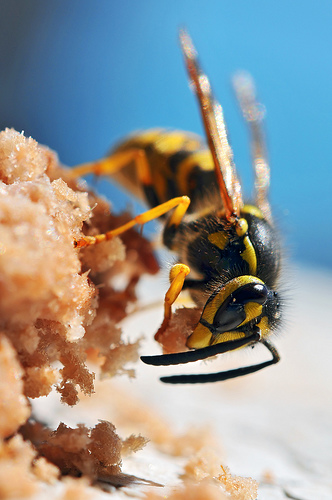Wasps Are Starting Nests in New England
By Chris Williams on April 10, 2014.
 We’re starting to see activity from bees, wasps, and hornets here in New Hampshire and Massachusetts. It seems that most people refer to all of these stinging insects collectively as “bees.” The poor bees get a bad rap when it’s usually wasps that are causing the problem.
We’re starting to see activity from bees, wasps, and hornets here in New Hampshire and Massachusetts. It seems that most people refer to all of these stinging insects collectively as “bees.” The poor bees get a bad rap when it’s usually wasps that are causing the problem.
Of all the wasps, yellowjackets are probably the most annoying and the most threatening. Did you know that in New Hampshire, we have at least 9 species of yellowjacket wasps, along with two hornets — the baldfaced hornet (technically a yellowjacket) and the giant European hornet. We also have paper wasps that build nests on our homes. The one thing they all have in common is that they live in colonies, but they differ in where those colony nests are found.
Not All Wasp Nests are in Trees
Most yellowjackets are ground nesters. Their nests are made up of layers of combs, yet all you can see of their colonies may be a nickel-sized entrance hole in the ground. Ground-nesting yellowjackets may or may not be a problem depending on how close the colony is to your deck or playground or front door. If you have several of these colonies in your yard, you will definitely notice the increased activity as the summer progresses. There can be a significant sting risk if someone walks across a ground nest entrance.
Other yellowjackets are void nesters, meaning that their colonies can actually be found in the walls or ceilings of our homes. These guys are obviously a problem. Although the entrance to their void nest is on the outside of your home, they sometimes chew their way through wallboard and end up in living areas. Even after the yellowjackets are eliminated, the nest left in the wall can smell and attract scavenging insects.
The black and white baldfaced hornet builds a large, paper-covered, pear-shaped nest usually high up in trees, but sometimes under the eaves of a building, or in low shrubbery.
The giant European hornet prefers to nest in holes in rotting trees, but will also build a covered paper nest in sheds, bird houses, attics, and wall voids. Although these wasps are large (about an inch long!), they are more docile than yellowjackets. European hornets are attracted to lights.
Paper wasps are sometimes called umbrella wasps because their single comb nest resembles an umbrella. Their nests are found under porch overhangs, under eaves, behind shutters, in attics, and in other sheltered places. These wasps are usually only a problem if their nest is near a doorway, traffic area, or play area.
If wasps are a problem in your yard or home, give Colonial a call. It’s always best to remove wasps’ nests while the colony is still small. Wasp colonies grow throughout the summer and by late summer can be very large indeed, with thousands of workers.
Photo credit: Tambako the Jaguar / Foter / CC BY-ND 2.0